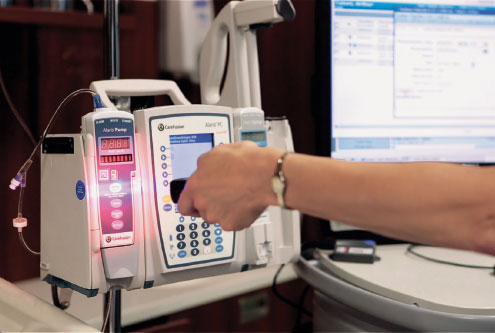Interoperability Preparedness: What Hospitals Can Do to Be Ready for Smart Pump-EMR Interoperability

By Tim Vanderveen, PharmD, MS; Nicole Wilson, RN, MSN, CPHIMS; Katie Moatsos, BS; Monica Obsheatz, RPh, MPM
The following article is based on the knowledge gained from implementation of infusion system–electronic medical record (EMR) interoperability at more than 135 hospitals to date. Many considerations go into preparing for safe and reliable smart pump–EMR interoperability. The authors realize that many infusion device companies are addressing these issues; however, as employees of BD/CareFusion, they have no direct knowledge of these efforts. The approaches suggested in this article are presented to help educate and encourage further discussion of what hospitals can do before the actual implementation begins to optimize the success of smart pump–EMR interoperability.
Smart pump–EMR interoperability is the new standard of care for intravenous (IV) infusion therapy. The IV route of administration for medications often results in the most serious outcomes of medication errors (Hicks, Cousins, & Williams, 2003). Despite the many advances made by computerized prescriber order entry (CPOE), bar code medication administration (BCMA), and intelligent infusion safety systems or “smart pumps” (Pettus & Vanderveen, 2013), problems remain. A study at a major medical center found that 67% of smart pump IV infusions have one or more errors associated with their administration (Husch et al., 2005). Multiple studies have pointed to the need for smart pumps to be interfaced with other medication use information systems, such as an EMR, CPOE, BCMA, and pharmacy information system (PIS), to generate meaningful improvements in patient safety (Husch et al., 2005; Russell, Murkowski, & Scanlon, 2009; Schnock et al., 2015).
Infusion device–EMR interoperability
With infusion system–EMR interoperability, bar code scanning is used to trigger the transmission of physician-ordered, pharmacist-reviewed infusion parameters from the EMR to pre-populate the smart pump, reducing the number of error-prone keystrokes used in manual programming. Time-coded infusion data—such as rate changes, pauses, starts, and stops—flows back into the patient’s EMR in near real time.
Interoperability also provides association between infusion pumps and specific patients, enabling accurate, time-stamped IV infusion data to improve charge capture and reimbursement. Interoperability can enable pharmacy to view the infusion status of all pumps to better plan pharmacy workflow and prepare infusions as close as possible to the time they are actually needed, reducing waste from discontinued and expired medications.
However, as ECRI has pointed out, infusion device–EMR interoperability can be “complex, difficult, and costly” (ECRI Institute, 2013). Infusion devices and the EMR were developed in separate “silos,” and many elements need to be aligned for interoperability to succeed. A change to any component of the separate systems affects all other components, and the work of one department affects all other departments. Fortunately, with more than 135 implementations completed, much has been learned to smooth the process, streamline implementation, and optimize success.
Preparing for interoperability
A growing number of hospitals have interoperability on their 24-month (or longer) road map, and they want to know how they can prepare (even before they contract with their vendors) to minimize anxiety, rush work, unplanned costs, and rescheduling.

